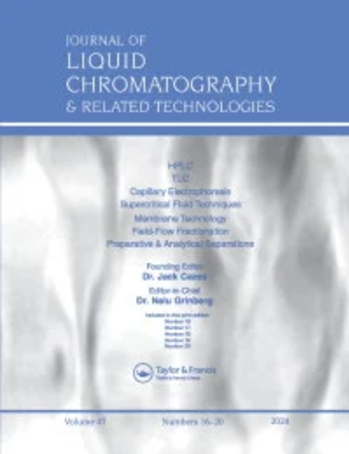Integrated methods for fingerprinting of monofloral honeys
IF 1
4区 化学
Q4 BIOCHEMICAL RESEARCH METHODS
Journal of Liquid Chromatography & Related Technologies
Pub Date : 2023-06-22
DOI:10.1080/10826076.2023.2224024
引用次数: 0
Abstract
Abstract Honey is an important functional food due to its content of polyphenolic compounds with beneficial effects on human body. The analysis of polyphenolic compound in honey is very promising in determination of floral origin and so for quality control. This study approaches a new methodology using integrated methods for the determination of honey authenticity. Polyphenolic compounds from seven different types of monofloral honey from two different sources were extracted and analyzed by thin layer chromatography (TLC) and UV-Vis spectroscopy. Chromatographic analysis was performed on TLC Silica gel 60 RP-18 F254 plates using a mobile phase consisting in a mixture of methanol: water: formic acid (5: 5: 0.1, v/v/v). The images from the TLC analysis were processed and the obtained chromatograms together with the UV-Vis deconvoluted spectra of honey were subjected to visual and statistical analysis. The obtained results showed notable differences between the honey samples, which can be used to establish their floral origin and for their authentication. The proposed methodology is easy to perform, cost-effective and offers complementary information, therefore it has the potential of being used for the honey authentication. GRAPHICAL ABSTRACT单花蜂蜜指纹图谱的综合方法
摘要蜂蜜是一种重要的功能性食品,它含有对人体有益的多酚类化合物。蜂蜜中多酚类化合物的分析在花源鉴定及质量控制方面具有重要的应用前景。本研究探讨了一种新的方法,使用综合方法来确定蜂蜜的真实性。从两种不同来源的七种不同类型的单花蜂蜜中提取多酚化合物,并用薄层色谱法和紫外-可见光谱法进行分析。在TLC硅胶60上进行色谱分析 RP-18F254板,使用由甲醇:水:甲酸(5:5:0.1,v/v/v)的混合物组成的流动相。对来自TLC分析的图像进行处理,并对获得的色谱图以及蜂蜜的UV-Vis去卷积光谱进行视觉和统计分析。所得结果表明,蜂蜜样品之间存在显著差异,可用于确定其花的来源和鉴定。所提出的方法易于执行,具有成本效益,并提供了补充信息,因此具有用于蜂蜜认证的潜力。图形摘要
本文章由计算机程序翻译,如有差异,请以英文原文为准。
求助全文
约1分钟内获得全文
求助全文
来源期刊
CiteScore
2.80
自引率
0.00%
发文量
29
审稿时长
4.9 months
期刊介绍:
The Journal of Liquid Chromatography & Related Technologies is an internationally acclaimed forum for fast publication of critical, peer reviewed manuscripts dealing with analytical, preparative and process scale liquid chromatography and all of its related technologies, including TLC, capillary electrophoresis, capillary electrochromatography, supercritical fluid chromatography and extraction, field-flow technologies, affinity, and much more. New separation methodologies are added when they are developed. Papers dealing with research and development results, as well as critical reviews of important technologies, are published in the Journal.

 求助内容:
求助内容: 应助结果提醒方式:
应助结果提醒方式:


